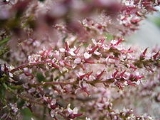
Tamarix gallica
Encyclopedia
Tamarix gallica, the French Tamarisk, is a deciduous, herbaceous, twiggy shrub or small tree reaching up to about 5 meters high. It is indigenous to Saudi Arabia
and the Sinai Peninsula
, and very common around the Mediterranean
region. It is present in many other areas as an invasive
introduced species
, often becoming a noxious weed. It was first described for botanical classification by the taxonomist
Carolus Linnaeus in 1753, but had already been in cultivation since 1596.
It has fragile, woody branchlets that drop off in autumn along with the small, scale-like leaves
that cover them. The leaf-shape is an adaption over time to exceedingly dry conditions.
The pink flower
s are tiny, hermaphroditic, and are borne on narrow, feather-like spikes. They frequently bloom earlier than the leaves, first in May, and sometimes a second time in August.
In its native range the plant grows in moist areas such as riverbanks, especially in saline soils. It has been grown as an ornamental plant
for its profuse production of showy pink flower spikes. In Algeria
and surrounding areas it has been used medicinally for rheumatism
, diarrhea
, and other maladies.
Saudi Arabia
The Kingdom of Saudi Arabia , commonly known in British English as Saudi Arabia and in Arabic as as-Sa‘ūdiyyah , is the largest state in Western Asia by land area, constituting the bulk of the Arabian Peninsula, and the second-largest in the Arab World...
and the Sinai Peninsula
Sinai Peninsula
The Sinai Peninsula or Sinai is a triangular peninsula in Egypt about in area. It is situated between the Mediterranean Sea to the north, and the Red Sea to the south, and is the only part of Egyptian territory located in Asia as opposed to Africa, effectively serving as a land bridge between two...
, and very common around the Mediterranean
Mediterranean Sea
The Mediterranean Sea is a sea connected to the Atlantic Ocean surrounded by the Mediterranean region and almost completely enclosed by land: on the north by Anatolia and Europe, on the south by North Africa, and on the east by the Levant...
region. It is present in many other areas as an invasive
Invasive species
"Invasive species", or invasive exotics, is a nomenclature term and categorization phrase used for flora and fauna, and for specific restoration-preservation processes in native habitats, with several definitions....
introduced species
Introduced species
An introduced species — or neozoon, alien, exotic, non-indigenous, or non-native species, or simply an introduction, is a species living outside its indigenous or native distributional range, and has arrived in an ecosystem or plant community by human activity, either deliberate or accidental...
, often becoming a noxious weed. It was first described for botanical classification by the taxonomist
Taxonomy
Taxonomy is the science of identifying and naming species, and arranging them into a classification. The field of taxonomy, sometimes referred to as "biological taxonomy", revolves around the description and use of taxonomic units, known as taxa...
Carolus Linnaeus in 1753, but had already been in cultivation since 1596.
It has fragile, woody branchlets that drop off in autumn along with the small, scale-like leaves
Leaf
A leaf is an organ of a vascular plant, as defined in botanical terms, and in particular in plant morphology. Foliage is a mass noun that refers to leaves as a feature of plants....
that cover them. The leaf-shape is an adaption over time to exceedingly dry conditions.
The pink flower
Flower
A flower, sometimes known as a bloom or blossom, is the reproductive structure found in flowering plants . The biological function of a flower is to effect reproduction, usually by providing a mechanism for the union of sperm with eggs...
s are tiny, hermaphroditic, and are borne on narrow, feather-like spikes. They frequently bloom earlier than the leaves, first in May, and sometimes a second time in August.
In its native range the plant grows in moist areas such as riverbanks, especially in saline soils. It has been grown as an ornamental plant
Ornamental plant
Ornamental plants are plants that are grown for decorative purposes in gardens and landscape design projects, as house plants, for cut flowers and specimen display...
for its profuse production of showy pink flower spikes. In Algeria
Algeria
Algeria , officially the People's Democratic Republic of Algeria , also formally referred to as the Democratic and Popular Republic of Algeria, is a country in the Maghreb region of Northwest Africa with Algiers as its capital.In terms of land area, it is the largest country in Africa and the Arab...
and surrounding areas it has been used medicinally for rheumatism
Rheumatism
Rheumatism or rheumatic disorder is a non-specific term for medical problems affecting the joints and connective tissue. The study of, and therapeutic interventions in, such disorders is called rheumatology.-Terminology:...
, diarrhea
Diarrhea
Diarrhea , also spelled diarrhoea, is the condition of having three or more loose or liquid bowel movements per day. It is a common cause of death in developing countries and the second most common cause of infant deaths worldwide. The loss of fluids through diarrhea can cause dehydration and...
, and other maladies.

